Genre: Shmup Developer: Technosoft Publisher: Sega of America Players: 1 Released: 1989
Wow. Outstanding. I can remember when this was one of the first titles on the Genesis. I can remember playing it for the first time. I can remember how absolutely awesome this was like. Seeing, hearing, and playing Thunder Force II seemed like no other shooter could even compare, and still shows its excellence today. Playing this title seemed like playing an arcade in your home. Every aspect of this game was incredible. And so marked the beginning of the series of Thunder Force games into the American market.
The dates have changed, but the situation is the same. The Lone Star System has once again waged war against the peaceful Planet Nebula. Her wounds only recently healed, it’s taken eighteen years for the planet to reverse the decimation and destruction the last attack left behind. Led once again by Reficul, Emperor of Lone, he’s launched a fleet of attack ships to thwart any attempts to stop him. And that includes you.
The mother ship Plealos is docked at Nebula’s spaceport. She and her crew are commanded by Reficul inside the ship. It’s your mission to pilot the super space jet Thunder Force II and guide it strategically to the port deep below the planet’s surface. To succeed, you need to survive. And that won’t be easy with five levels of intricate places to pass through where ultra-combat weapons wait to demolish your ship.
If you’re anybody who has played any of the Thunder Force series, you know you don’t really play it for the storyline. The story line is okay at best, but certainly nowhere near wonderful. Everyone plays the Thunder Force series for its quality of gameplay, and this game has just about everything going for it.
Although the manual, which is obviously written by a poorly staffed Sega at the time, describes that the game has five stages, the actually is that there are nine. Thunder Force II has two different types of stages. The first is a top-view and the second is the side-view. Depending on which stage you currently playing, the objective is a little different. The top-view levels do not restrict you to a straight-forward, vertically scrolling game like many of the other shooters do. There is not even a boss for the top-view levels. Instead, the player is given the ability to fly in all eight directions.
The objective is to find the four bases spread out around the level in the different areas and destroy them. The bases are located on the ground, which brings me to the next point. The ship can fire both in the air and bomb the ground at the same time. The player must worry about not only what is all around him in the air, but also what structures on the ground are firing up at the ship too. Now, once all the bases are found and destroyed, it’s on to the next level.
After a top-view stage is done, it’s on to a side-view mission. The side-view stages are different. This time, it’s like some of the other typical side-scrollers, consisting of dodging and destroying enemies and enemy fire, along with a mini-boss and a boss at the end of the level. Not only do the top-view and side-view areas look different and play a little different than each other, they also have some different weapons. The ship starts with a default of two weapons, the Twin Shot and the Backfire. On the top-view mission as you are destroying ground targets and bases, an occasional blue ship will come on screen to destroy and it releases a power-up, giving you a new weapon. Also every time you pick up a power-up, a computer-synthesized sounding voice says the name of it, which sounds pretty cool.
The first is the Wider shot, which upgrades the backfire weapon to a four-way shooting weapon. Next is Five-Way, shooting 5 projectiles in a forward formation. Then there is Destroy, which has a weak forward shooting weapon, but bombs in 3 different directions to give ease in destroying ground targets even faster. Clash is a weird weapon, shooting rings out from the ship in a circular like motion and is good for multiple hits on targets fast. Probably one of the favorites and best weapons which has remained through-out the Thunder Force series is Hunter. You cannot bomb targets while using it, but the weapon will automatically seek out and home in on any targets on screen and destroy them, regardless of the direction they are in. Lastly, The original Twin Shot the ship comes with can be upgraded to Laser, firing a piercing thin beam straight forward, slicing any enemy to pieces.
Now this arsenal listing is only for the top-view missions. The side-view missions bestow a slightly different array of weapons to use. The Twin Shot and Backfire are still the default weapons given once you start your first side-view stage but their upgrades, Laser and Mega Flash, are very different than the top-view upgrades for Twin Shot and Backfire. One of the coolest weapons and easily the most used is Wave, which fires in a wave-like motion forward, but the main advantage is how the pattern helps to take out enemies, plus the firepower can go through walls. Next is the Side Blasters, which fires shoots above and below you to help take out enemies positioned on the ceiling or ground.
Then there is Nova. Nova fires a three-way shot, but it will shoot in the opposite direction that your ship moves towards. So if you move the ship towards the left, it will fire to the right. Lastly, there is Hunter that homes in on the enemies just like it did before. Also, to add to the helpful array of weaponry as before on the top-views, one or two claws can be obtained that will rotate around the ship and absorb enemy fire. There is even another power-up for the claw called Roll, that for a short period of time, will make the claws work and rotate faster. Oh yeah, there is a shield that can be obtained too that will work for a limited period of time, just as the same for the top-views.
For the time that Thunder Force II hit the market, the graphics were phenomenal. The graphics helped to give the feel that you were actually playing an arcade game in your home. Everything about the graphics shine, from the use of the weapons to the areas you fly through. The second top view mission is probably one of the cooler looking levels because it looks like a you are flying over a city, with tons of blinking colored lights shining up from below. The artistic design and feel here is brilliant, but what is also cool is the use of foreground obstacles like walls, buildings, and other structures that, if you are not paying attention, can come scrolling onto the screen suddenly and cause you to collide with it. This will certainly keep you on your toes.
The side-view levels are just as cool looking as the top-views, some better than others. Probably the most impressive is the first side-view mission where you are flying through an enemy spaceport. Being attacked by wild looking enemy ships is cool, but the detail of the foreground and background in particular impressed me. Filled with towering steel pillars and docked ships in the back certainly brought a cool look to the game. And every level is different. Usually, the side-view mission will correspond graphically to the motif of the top-view mission before it. This once again gives a greater in-depth feel to the player. When looking back at this game, even today, I still can find games made by higher budget companies that still cannot do the standard excellence this title produced several years ago in gaming market.
The music is absolutely outstanding. All the themes made by this company still sound great in comparison to even games made on the Genesis in its final years on the market. The music tracks were great, and especially sounded good with headphones. Once again, it had sounded as if actual arcade quality had finally been achieved. Thunder Force‘s themes are so good that I am still comfortable listening to them today, even if it is only for nostalgia. As for the sound effects, the exact same can be spoken in terms of its unique quality. Many different sounds were used for various effects and they all go together nicely with the entire package. I was just extremely glad that Technosoft was nice enough to put a sound test in for us and without a dumb passcode to use to access it either. To say it all, the music and sound are but one of the many attributes that Technosoft would become so well known for.
The challenge level of Thunder Force is fully present. The top-view levels are fast-paced, with continuous bombardments of enemies that can come from any direction, while the side-view stages are full of narrow passages, lots of enemies and plenty of obstacles to avoid. Probably one of the only mentionable flaws of the game is the lack of a speed power-up or manual adjustment of the ship’s speed. The ship always flies at one set speed. While this really isn’t much of a problem, it could be to other players, especially on top-view levels, so the option should have been present.
Speaking of options, here’s the low-down from the options menu. The Difficulty can be adjust from Training (easy), Normal (default), or Hard. Players can also, if they wish, choose to start from any of the first five stages. Also, the number of ships can be changed from the default of four up to five, or down to three ships. If a player wishes to really wear out their thumbs, they can even turn the rapid fire feature to off (why anyone would do this, I don’t know). And lastly, the music and sound effects can be listen to by choosing the appropriate number. This is a feature I was very happy to have.
I don’t think Sega could have chosen a better title to port over to the states to help promote the Genesis at the time than Thunder Force II from Technosoft. Absolutely every aspect of the game gleams with excellence and is a definite keeper to any shooter fan. Also, you are not a hard-core Thunder Force junkie if you do not own this game. With superior design creating fun gameplay, this game is it, without a doubt. And if you haven’t guessed, this title comes highly recommended. So get off your butt and go find a copy before they become any harder to find
Originally printed at Starbase299.
SCORE: 9 out of 10

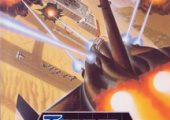
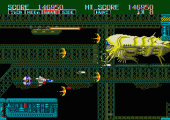
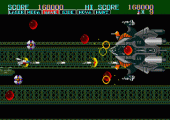
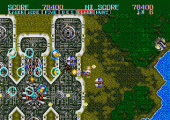
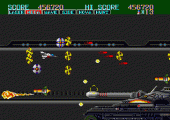
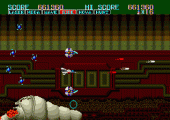
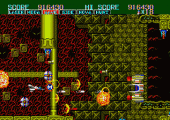
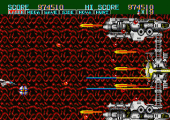
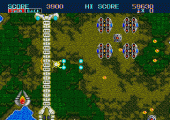
I wanted to like this game but… the biggest issues I have with this game are having to make jerky directional changes in the overhead stages for things that need multiple hits (because of the ship motion speed), and that some of the horizontal stages have objects like closing walls that have to memorized or else it’s a forced loss of a turn.
While this game has some qualities, like most of the graphics and the core gameplay I have to agree with goldenband on the UI. Another thing is that if you for example start on stage 5, you don’t go to the final boss after you’ve completed all other stages, instead you do stage 5 and up again! The music is a hit and miss. I like some tracks, some are just too depressive (almost all tracks go in minor scales) and weird. I have nothing against the top-down levels, but they would have been much better if your ship wasn’t so fast and the weapons were so weak.
I guess it was amazing back when it was released, but some design decisions just aren’t my bag. I much prefer the two sequels which later appeared on the system.
It’s tough for me to appreciate what it must have been like to play this back in the day. On its own, it’s a challenging shooter with some interesting ideas, but flawed execution. There are also some truly strange UI decisions, like pressing A to continue (Start ends the game!), or having to hold A+Start to access the Options menu and then, once you’ve chosen your options, getting bumped back to the Sega logo instead of just starting the game. I don’t know why Sega insisted on doing that in some of the early first-party titles, it’s really annoying.
Once you figure out where to go in the overhead levels, they’re mostly not that hard, though the third one is unpleasant. The final boss fight kinda sucks, though, especially at the end. There’s no real feedback to let you know when you’re damaging the boss’s core, and it feels like a tactic to make the game harder by being obscure and time-consuming, rather than by offering a satisfying challenge. Also, having to constantly be in motion gets fatiguing after a while, and reminds me of my preference for Granada over this game.
The side-scrolling levels are OK, and I actually came to enjoy the first part of Level 4 (which seemed overly difficult at first). However, I hate that cheap “let’s finish by scrolling really fast and trapping the player in unforeseeable dead ends” nonsense. It wasn’t acceptable design then, and isn’t now.
Anyway, I think the most telling thing is that it wasn’t that hard to beat this game, but I have no real urge to play it again. 6/10.